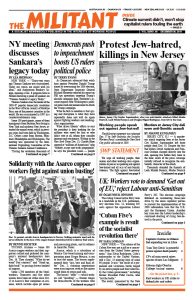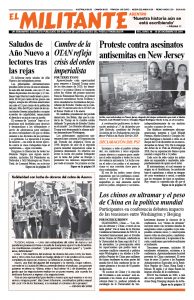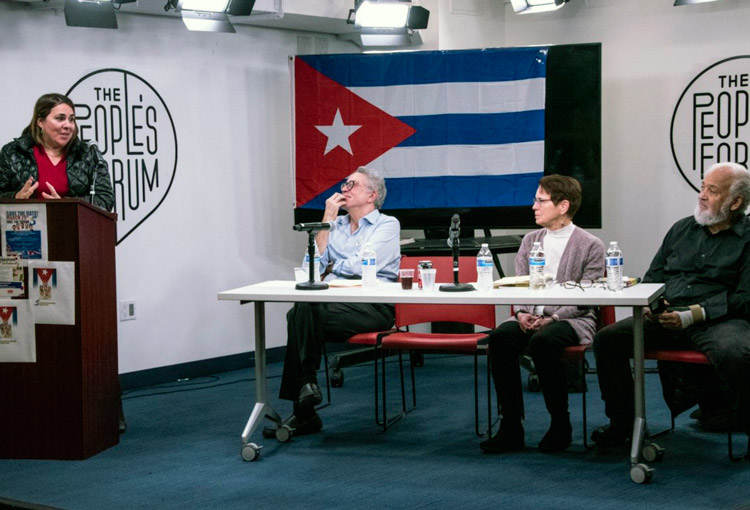NEW YORK — “The release of the Cuban Five was not a gift or a concession from the United States government,” Ana Silvia Rodríguez, Cuba’s ambassador to the United Nations, told a Dec. 14 meeting here of some 90 people. It was “the result of a permanent and victorious battle waged by an entire people and their relatives, by the Cuban government,” including former President Fidel Castro, who “led the battle.”
The event, sponsored by the New York-New Jersey Cuba Sí Coalition, celebrated the fifth anniversary of the release of Gerardo Hernández, Ramón Labañino and Antonio Guerrero on Dec. 17, 2014. Fernando González, and René González had completed their terms and been released earlier.
The Cuban Five, as they were known, were arrested in Florida in 1998 and framed by the U.S. government for their actions to protect Cuba from bombings and other deadly attacks launched from U.S. territory by Washington-backed counterrevolutionaries. They were given sentences ranging from 15 years for René González to double life plus 15 years for Hernández.
Ike Nahem from the Cuba Sí coalition opened the program, held at the People’s Forum in midtown Manhattan. Claudia de la Cruz, the forum’s executive director, introduced Ambassador Rodríguez.
Cuba owes the freedom of the five heroes, Rodríguez said, to the 15-year-long international campaign to demand their release.
These five men “were not seeking prizes or personal glories. They were only trying to prevent and stop terrorist attacks against their people,” the ambassador said. “They never gave up their principles.”
Nancy Cabrero, former president of Casa de las Americas in New York and a longtime defender of the Cuban Revolution, co-chaired the meeting. She described many of the activities to free the Cuban Five held here.
Cabrero introduced Mary-Alice Waters, who corresponded with each of the Cuban Five while they were in prison and edited several books about the fight to free them. These include “It’s the Poor Who Face the Savagery of the US ‘Justice’ System”: The Cuban Five Talk About Their Lives Within the US Working Class, an interview with the Five after their return to Cuba. Waters is president of Pathfinder Press and a leader of the Socialist Workers Party.
Waters recalled the “intense joy” felt by her and thousands of others upon hearing that Gerardo, Ramón and Antonio were back on Cuban soil.
Cuban 5 example for working people
Waters focused her remarks on the political example set by the Cuban Five for working people and youth in the U.S. and the world over. Through them, she said, “we see the real character of Cuba’s socialist revolution — the kind of men and women forged by that revolution.”
“They were held prisoner through three U.S. administrations — two Democratic and one Republican,” Waters said. “From inside federal prisons where they were held across the country, they were on the frontlines of the class struggle in the United States.”
“Through their integrity and conduct, each of the Cuban Five gained the respect of their fellow prisoners, and it was these working people behind bars who became their first line of defense,” she said.
Waters noted that 97% of those in federal prisons are there due to plea bargains — that is, coerced to “cop a plea” without a trial before a jury of their peers. The simple fact that the Five insisted on a trial, Waters said, and refused to “cooperate” with prosecutors, meant they became known as people who could be trusted.
“When they returned to prison from the Miami courtroom in June 2001 after the guilty verdicts,” she added, “they were greeted with an outburst of applause from fellow prisoners.”
Three of the five, Hernández, Fernando González and René González, each served in Angola as part of the Cuban mission to help defeat the South African apartheid regime and its invading army. Some 425,000 Cubans were part of this effort between 1975 and 1991. This also gained them respect among many prisoners, especially African Americans.
On returning to Cuba, Waters said, the Five spent a year visiting every area of Cuba, as well as other countries, contrasting the brutalities of life and the so-called justice system under U.S. capitalism to the accomplishments and transformation of human beings and social values as a result of the socialist revolution in Cuba.
‘Our conduct product of revolution’
Waters concluded by quoting Guerrero’s response to a Cuban student who asked where the Five got “the strength to create art” in prison. “Anyone can write a poem,” Guerrero replied. “But to spend 17 months in the hole and 16 years in prison and create paintings that don’t contain a shred of hatred or bitterness, but rather optimism, love and freedom — that’s different. That’s a product of the way we were educated as revolutionaries. It’s something we were able to achieve thanks to the revolution.”
The concluding featured speaker was Martin Garbus, the lead attorney for the Cuban Five following the 2011 death of Leonard Weinglass, who had led the legal team. Garbus, a well-known trial lawyer, recently released North of Havana: The Untold Story of Dirty Politics, Secret Diplomacy, and the Trial of the Cuban Five.
“When I visited Gerardo at [the Federal Penitentiary in] Victorville [California], you could see the respect everyone had for him,” Garbus said. “No one had the reputations the Five had. They were respected by everyone.”
“The Cuban Five collectively spent 75 years in prison,” he said. “In all that time, not one of them picked up a single infraction — an almost inconceivable feat in a U.S. federal prison.”
Reading excerpts from his new book, Garbus cited FBI and other documents — some from case files, others more recent — that exposed how federal prosecutors patched together their frame-up.
There’s nothing new about “fake news,” Garbus said. He explained how journalists for the Miami Herald — whose false and inflammatory articles slandered the Cuban Five during and after their trial — were on the U.S. government payroll.
Documents produced by the legal team for the Five showed that the U.S. government’s Office of Cuba Broadcasting paid thousands of dollars to seven reporters starting in 1999, including $80,000 to five reporters during the trial itself.
Solidarity messages were given by Ben Ramos, from ProLibertad and the Popular Education Project; Bill Sacks from Workers World Party; former Black Panther Tarik Haskins, railroaded to prison for 17 years and now with the Universal Zulu Nation; and Yhamir Chabur, a participant in the 2019 Venceremos Brigade to Cuba. Taped greetings were played from Mumia Abu-Jamal, who was framed up and railroaded to prison in Pennsylvania in 1982, who has had to fight to get the medical care he needs.
North of Havana, “It’s the Poor Who Face the Savagery of the US ‘Justice’ System” and other books about the Cuban Revolution were available at the celebration for those who wanted to find out more about their victorious fight.


